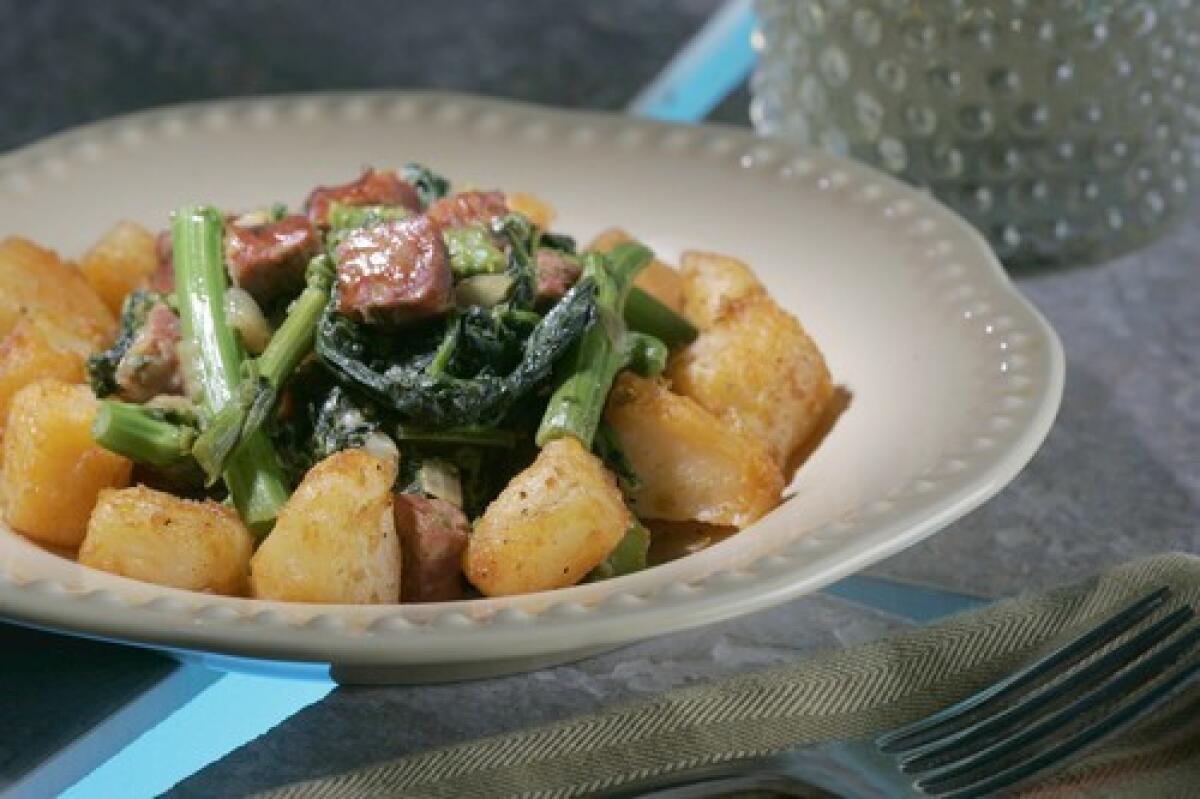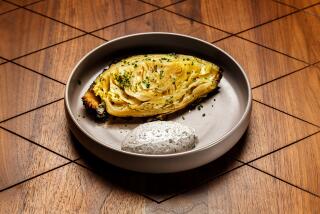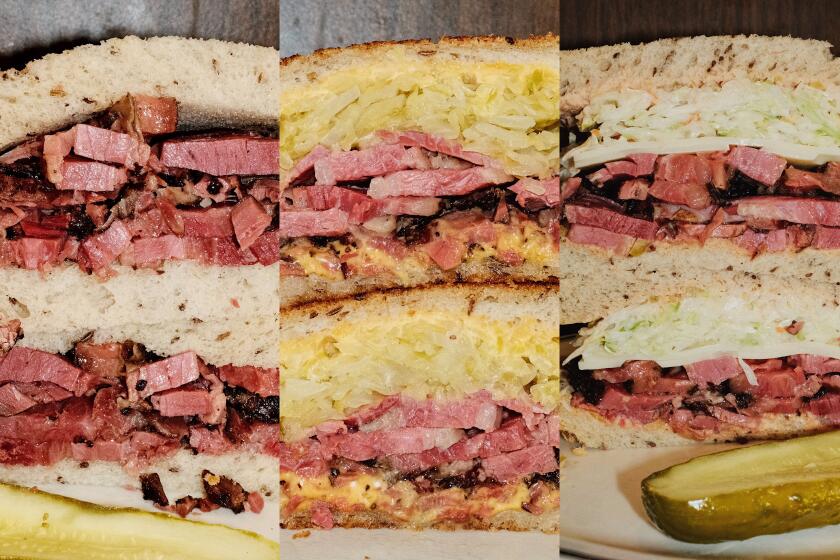The sweet side of bitter greens

LOOK at the wildly tangled leaves of curly endive, the furiously jagged edges of dandelion greens, the deep furls of escarole and right off you know there’s something about them that’s just begging to be tamed.
It’s a bit of a paradox. These greens are loved for their bitter bite, but harnessing that bite — say, by adding the spice of chiles or the sweetness of bacon or by giving them a quick blanch or even just a sauté — is what makes them sing.
And at this time of year, bitter greens are calling from nearly every other stall or stand at the farmers market or the grocery store; they’re a boon of winter. Until fairly recently, bitter greens have been popular in this country only in the South, but more of them have become more widely available, though their names still can be confusing. Greens in the chicory and endive family include Belgian endive (also called French endive and witloof), curly endive (sometimes called chicory or frisée), escarole and several varieties of radicchio. Then there are dandelion greens, mustard greens and turnip greens (yes, keep the tops of your turnips).
Maybe our bent for bitter greens started with the exploding popularity of rapini — or broccoli rabe — a green brought to the U.S. by Italian immigrants. Its deep, complex flavor has everything to do with its bitterness, and it’s wonderful punctuated by a shower of Parmesan, a dash of bottarga (dried mullet roe) or a dose of spicy sausage.
Cooking, whether a slow simmer or quick sauté, is the first step in taming bitter greens. Heartier varieties such as turnip greens require a longer cook time to reduce their bite and soften their texture. Tender leaves such as frisée can be mellowed with just a quick toss in a warm vinaigrette, though their bitterness is so gentle that you can also serve them untamed.
Traditional recipes might insist that greens be cooked a minimum of an hour, or require long preblanching times for even delicate greens such as escarole. These methods do remove much of the bitterness of greens, but they also remove a lot of their color and texture.
Unless you like your greens on the soft side, reserve blanching and braising for very sturdy greens such as rapini. It can take a slightly longer cook time than more delicate greens, and blanched rapini is noticeably less bitter after cooking than when it is added to the pan raw.
Whether cooked to softness or barely wilted, bitter greens benefit greatly from three simple additions: salt, fat and spice.
Salt takes the edge off bitterness in any food, and that’s especially true with bitter greens. And these have the backbone to stand up to salt in some of its most potent forms. In southern Italy, cooks often use anchovies to season and add depth to simple dishes such as braised escarole or dandelion greens (whatever’s in season) with garlic and olive oil. Or you can go the Asian route: Soy sauce, with its slightly sweet, rich flavor, rounds and balances the flavor of mustard greens or turnip greens too.
Fat is the great equalizer; it not only softens harsh tastes, it also brings flavors together on the palate. It doesn’t take much — a little olive oil is enough to meld the assertive flavors of garlic, chile and escarole and make them all work perfectly together. Add a little more richness in the form of soft polenta made with a bit of cream and grated Fontina or Parrano cheese, a pale yellow cow’s milk cheese from Holland, and you have an ideal base for simple sautéed greens. And then there’s sausage — rapini with Italian sausage is a no-brainer. Pair rapini with linguiça and roasted potatoes, though, and you get a Portuguese take on the Italian green, inspired by a traditional dish called caldo verde. The linguiça is mild and smoky and unctuous, and the fattiness of the meat brings out the texture and flavor of the rapini.
Turnip greens are too often overlooked, tragically tossed aside. But they’re the stand-out in a Caribbean-style soup made with crab, bacalao (salt cod), creamy coconut milk and chiles. The salt cod, coconut and peppers provide an intriguing base in this soup, but the turnip greens make the dish. Traditionally, callaloo soup is made with callaloo leaves or spinach, but the turnip greens are as tender and delicious, and it’s their edge of bitterness that sets this soup apart.
food@latimes.com
*Rapini with linguiça and golden roasted potatoes
Total time: 1 hour
Servings: 4
Note: Rapini is also called broccoli di rape or broccoli rabe. Linguiça, a Portuguese sausage, is widely available in supermarkets.
1 bunch rapini, ends of stems trimmed (about 1 1/2 pounds)
2 large russet potatoes, peeled and cut into 3/4 -inch cubes (about 3 cups, diced)
4 tablespoons olive oil, divided
3/4 teaspoon paprika, divided
1 teaspoon minced garlic
Salt and freshly ground black pepper
1 cup chopped onions
2 links (about 10 ounces) linguiça or Spanish chorizo, cut into 1/2 -inch cubes
1/4 cup chicken stock
1. Bring a large, wide-rimmed pot of salted water to a boil. (Use about 1 tablespoon of salt for every 2 quarts of water.) Place a baking sheet inside the oven and heat the oven to 375 degrees.
2. Blanch the rapini in the boiling water until just tender, about 2 minutes. Remove with tongs or a strainer and place in a colander to drain, but do not discard the cooking water. Bring the water back to a boil. When the rapini is cool enough to handle, trim it into 2-inch pieces.
3. Cook the potatoes in the boiling water until tender, about 10 minutes. Drain the potatoes in a colander, shaking them to break up the edges a bit. Wipe any potato bits out of the blanching pot and return it to the stove.
4. Carefully remove the hot baking sheet from the oven. Pour 3 tablespoons of olive oil on the sheet and mix one-half teaspoon of paprika and the garlic into the oil. Put the potatoes on the sheet, stirring to thoroughly coat. Sprinkle with 1 teaspoon salt and a little pepper. Bake 20 minutes, stirring once or twice, until the potatoes have a nice crust.
5. Heat the remaining olive oil in the pot on the stove over medium heat. Add the onions and sauté until golden and tender, about 8 minutes. Add the remaining one-fourth teaspoon paprika; stir to mix thoroughly. Add the sausage, stir to coat with the oil, and cook 30 seconds. Add the rapini and chicken stock. Stir to mix the sausage and onions with the rapini, cook over medium heat until the rapini is tender, about 15 minutes. Add salt and pepper to taste. To serve, place 1 cup rapini mixture in the center of a warmed soup bowl. Surround with the roasted potatoes.
Each serving: 642 calories; 26 grams protein; 44 grams carbohydrates; 3 grams fiber; 41 grams fat; 12 grams saturated fat; 62 mg. cholesterol; 1,520 mg. sodium.
*Crab and greens soup with coconut milk
Total time: 25 minutes, plus 12 to 24 hours soaking time
Servings: 6
Note: Salt cod is available at Whole Foods Markets, Bristol Farms stores and Santa Monica Seafood.
6 ounces salt cod
1 tablespoon olive oil
1 cup chopped red onion
1 tablespoon peeled, grated ginger
2 serrano peppers, chopped
2 teaspoons toasted, ground coriander seeds
1 large bunch turnip or other greens, center ribs removed, cleaned and chopped (about 10 cups)
4 cups chicken stock
12 ounces fresh lump crab meat
1 (14-ounce) can coconut milk
2 tablespoons lime juice, plus more to taste
1/2 teaspoon sugar (use more or less according to taste)
Salt
1. Soak the salt cod in cold water for 12 to 24 hours in a sealable plastic bag, changing the water every 4 to 5 hours if possible.
2. Drain the cod, place it in a heatproof bowl or dish and cover it with boiling water. Soak for 15 minutes. Drain, then remove the skin and shred the flesh into small pieces.
3. Heat a heavy, large saucepan over medium heat. Add the olive oil. Add the onions and cook until softened, about 5 minutes. Add the ginger, serrano peppers and coriander; cook 1 minute. Add the greens and salt cod and cook until the greens wilt, about 5 minutes. Add the stock and bring it to a simmer, cooking on low heat for 15 minutes. Add the crab, coconut milk, lime juice and sugar. Taste and adjust seasonings, adding more lime juice, salt or sugar if needed. Serve hot.
Each serving: 431 calories; 38 grams protein; 26 grams carbohydrates; 16 grams fiber; 24 grams fat; 14 grams saturated fat; 100 mg. cholesterol; 402 mg. sodium.
*Escarole with aged Parrano cheese and soft polenta
Total time: 45 minutes
Servings: 6
Note: Parrano cheese is available at Whole Foods markets. Fontina can be substituted.
2 pounds escarole
4 cups chicken stock
1 cup heavy cream
3/4 teaspoon salt, plus more to taste
1 cup polenta
1/2 cup grated aged Parrano cheese
1 tablespoon olive oil
4 cloves garlic, minced
1/4 teaspoon crushed red pepper
Parmesan cheese, for shaving
1. Wash the escarole leaves in two changes of water. Trim the stems. Set aside the very tender yellow-green core, reserving for salads. Dry and cut the leaves into strips about one-half inch wide.
2. In a heavy saucepan, combine the stock and cream and bring the mixture to a boil. Add three-fourths teaspoon salt, then whisk in the polenta. Cook over low heat, stirring constantly with a wooden spoon, for 20 to 30 minutes, until the polenta is thick, soft and creamy. Stir in the Parrano cheese.
3. In a large sauté pan, heat the olive oil over medium heat. Add the garlic and sauté until soft, about 2 minutes. Stir in the red pepper. Add the escarole. You may need to allow half the escarole to wilt in the pan before adding the rest. When the leaves have begun to wilt, stir them carefully so that they become evenly mixed with the sautéed garlic. The greens are done when they are tender and wilted, about 10 minutes. Season to taste with salt. Serve the escarole on top of the polenta. Garnish with shaved Parmesan.
Each serving: 343 calories; 11 grams protein; 32 grams carbohydrates; 7 grams fiber; 20 grams fat; 11 grams saturated fat; 60 mg. cholesterol; 484 mg. sodium.
More to Read
Eat your way across L.A.
Get our weekly Tasting Notes newsletter for reviews, news and more.
You may occasionally receive promotional content from the Los Angeles Times.










